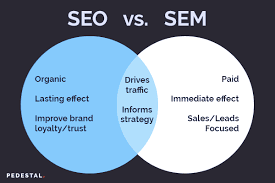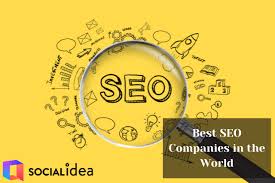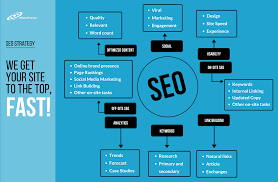SEO vs. SEM: Understanding the Difference for Effective Marketing
In today’s digital landscape, having a strong online presence is crucial for businesses to succeed. Two common strategies used to enhance visibility and drive traffic to websites are Search Engine Optimization (SEO) and Search Engine Marketing (SEM). While these terms are often used interchangeably, they represent distinct approaches to online marketing. Understanding the difference between SEO and SEM is essential for crafting an effective marketing strategy.
Search Engine Optimization (SEO) focuses on improving a website’s organic or unpaid search engine rankings. It involves optimizing various elements of a website, such as content, meta tags, and site structure, to make it more search engine-friendly. The goal of SEO is to increase visibility in search engine results pages (SERPs) for relevant keywords and phrases.
Effective SEO involves thorough keyword research to identify the terms people use when searching for products or services related to your business. By strategically incorporating these keywords into your website’s content and optimizing other technical aspects, you can improve your chances of ranking higher in organic search results.
SEO offers several benefits for businesses. Firstly, it helps drive targeted organic traffic to your website, resulting in higher quality leads and potential customers. Secondly, it establishes credibility and trust with users since top-ranking websites are often perceived as more reputable. Lastly, SEO provides long-term benefits by creating a solid foundation that can continue attracting organic traffic over time.
On the other hand, Search Engine Marketing (SEM) involves paid advertising campaigns that aim to increase visibility in search engines’ sponsored listings or advertisements section. Unlike SEO, which focuses on organic rankings, SEM utilizes platforms like Google Ads or Bing Ads to display ads based on specific keywords or audience demographics.
SEM allows businesses to bid on relevant keywords and pay only when users click on their ads (pay-per-click or PPC). This method offers immediate visibility in SERPs and enables precise targeting options based on location, device type, time of day, and more. SEM campaigns can be highly targeted, reaching users actively searching for products or services similar to what you offer.
One significant advantage of SEM is its ability to provide instant results. Unlike SEO, which may take time to see noticeable improvements in organic rankings, SEM campaigns can generate immediate traffic and conversions. Additionally, SEM offers flexibility in terms of budget control and campaign optimization, allowing businesses to make real-time adjustments based on performance data.
While SEO and SEM are distinct strategies, they are not mutually exclusive. In fact, combining both approaches can yield the most effective results. By implementing a well-rounded marketing strategy that includes both SEO and SEM, businesses can maximize their online visibility and increase the likelihood of reaching their target audience.
In conclusion, SEO and SEM are two essential components of a successful online marketing strategy. SEO focuses on optimizing a website’s organic search rankings through various techniques and content optimization. On the other hand, SEM leverages paid advertising to achieve immediate visibility in search engine results. By understanding the differences between these approaches and utilizing them strategically, businesses can enhance their online presence, attract more qualified leads, and ultimately drive growth in today’s competitive digital landscape.
7 Frequently Asked Questions about SEO and SEM in Digital Marketing
- What is SEM and SEO in digital marketing?
- What is SEO vs SMO vs SEM?
- How to do marketing on SEO and SEM?
- Is Google Ads SEO or SEM?
- What is SEO in digital marketing?
- What is SEO in marketing?
- What is SEO and SEM mean?
What is SEM and SEO in digital marketing?
SEM and SEO are both crucial components of digital marketing strategies aimed at increasing online visibility and driving traffic to websites. While they share similar goals, they differ in their approaches and execution.
1. Search Engine Optimization (SEO):
SEO refers to the practice of optimizing a website’s content, structure, and technical elements to improve its visibility in organic search engine results. The primary objective of SEO is to rank higher on search engine results pages (SERPs) for relevant keywords and phrases.
Key aspects of SEO include:
– Keyword research: Identifying the keywords and phrases that users commonly search for when looking for products or services related to a business.
– On-page optimization: Optimizing various elements within a website, such as meta tags, headings, URLs, and content, to align with targeted keywords.
– Off-page optimization: Building high-quality backlinks from other reputable websites to increase the website’s authority and credibility.
– Technical optimization: Ensuring that the website has proper site structure, fast loading times, mobile-friendliness, and easy navigation.
The benefits of effective SEO include increased organic traffic, improved brand visibility and credibility, long-term sustainability in search rankings, and better user experience on the website.
2. Search Engine Marketing (SEM):
SEM involves paid advertising campaigns aimed at increasing a website’s visibility in search engine results through sponsored listings or advertisements. The most common platform for SEM is Google Ads (formerly known as Google AdWords), although other search engines like Bing also offer similar advertising options.
Key aspects of SEM include:
– Keyword targeting: Selecting relevant keywords that trigger ads when users search for them.
– Ad creation: Designing compelling text or display ads that entice users to click on them.
– Bidding strategy: Determining how much you are willing to pay for each click (cost-per-click) or impression (cost-per-thousand impressions).
– Ad extensions: Enhancing ads with additional information like phone numbers, site links, or location information.
– Campaign optimization: Monitoring and adjusting campaigns based on performance data to improve results and return on investment (ROI).
SEM offers immediate visibility in search engine results, precise targeting options, and the ability to control budgets and campaign settings. It can generate quick traffic and conversions, making it an effective strategy for businesses looking for immediate results.
In summary, SEO focuses on optimizing a website’s organic search rankings through various techniques, while SEM utilizes paid advertising to achieve immediate visibility in search engine results. Both strategies are important in digital marketing as they complement each other and help businesses maximize their online presence.
What is SEO vs SMO vs SEM?
SEO, SMO, and SEM are three distinct strategies that businesses can use to enhance their online presence and drive traffic to their websites. While they share similarities, each approach serves a different purpose. Let’s explore the differences between SEO, SMO, and SEM:
Search Engine Optimization (SEO):
SEO focuses on optimizing a website’s visibility in organic search engine results. It involves various techniques and strategies to improve a website’s ranking for specific keywords or phrases. The goal is to attract organic (unpaid) traffic by making the website more search engine-friendly. SEO involves on-page optimization (such as keyword research, content optimization, meta tags), technical optimization (site structure, page speed), and off-page optimization (backlink building). The primary objective of SEO is to increase organic rankings and drive targeted traffic to the website.
Social Media Optimization (SMO):
SMO refers to optimizing a brand’s presence on social media platforms to increase visibility and engagement with the target audience. It involves creating and sharing valuable content across social media channels like Facebook, Twitter, Instagram, LinkedIn, etc., with the aim of attracting followers and encouraging them to engage with the brand. SMO includes activities such as content creation, community management, responding to comments/messages, running social media campaigns, and analyzing metrics like reach and engagement. The main focus of SMO is to build brand awareness, foster customer engagement, and drive traffic from social media platforms.
Search Engine Marketing (SEM):
SEM combines paid advertising with search engine results pages (SERPs) to increase a website’s visibility in search engines. It involves running paid campaigns through platforms like Google Ads or Bing Ads by bidding on specific keywords or demographics. SEM enables businesses to display ads alongside organic search results or in prominent positions within SERPs. The primary goal of SEM is to generate immediate visibility and drive targeted traffic through paid advertisements.
In summary:
– SEO focuses on optimizing a website’s organic search rankings to attract targeted traffic.
– SMO involves optimizing a brand’s presence on social media platforms to build awareness and engage with the audience.
– SEM combines paid advertising with search engine results to achieve immediate visibility and drive targeted traffic.
By understanding the differences between SEO, SMO, and SEM, businesses can develop comprehensive marketing strategies that leverage each approach effectively to enhance their online presence and achieve their marketing goals.
How to do marketing on SEO and SEM?
Implementing effective marketing strategies for SEO and SEM requires careful planning and execution. Here are some key steps to follow:
SEO Marketing:
Keyword Research: Conduct thorough keyword research to identify relevant terms and phrases that your target audience is searching for. Use tools like Google Keyword Planner or SEMrush to find keywords with high search volume and low competition.
On-Page Optimization: Optimize your website’s content, meta tags, headings, and URLs with the identified keywords. Ensure that your content is engaging, informative, and well-structured for both users and search engines.
Technical SEO: Improve your website’s technical aspects, such as site speed, mobile-friendliness, crawlability, and indexability. Optimize your robots.txt file, XML sitemap, and fix any broken links or errors.
Link Building: Develop a robust backlink strategy by acquiring high-quality links from reputable websites in your industry. Focus on natural link building through guest blogging, content promotion, influencer outreach, or partnerships.
Content Marketing: Create valuable and shareable content that aligns with your target audience’s needs and interests. Publish blog posts, articles, infographics, videos, or podcasts regularly to attract organic traffic and build brand authority.
SEM Marketing:
Campaign Setup: Set up an account on a search engine advertising platform like Google Ads or Bing Ads. Define your campaign goals (e.g., brand awareness or lead generation) and target audience based on demographics, location, interests, etc.
Keyword Selection: Choose relevant keywords for your ads based on user intent and relevance to your products/services. Use tools like Google Ads Keyword Planner to identify popular keywords with reasonable competition levels.
Ad Creation: Craft compelling ad copy that includes relevant keywords in the headline and description lines. Highlight unique selling points (USPs), include a clear call-to-action (CTA), and use captivating visuals if applicable.
Bid Management: Set your budget and bidding strategy for your campaigns. Monitor the performance of your ads, adjust bids based on keyword performance, and allocate budget to high-converting keywords or ad groups.
Landing Page Optimization: Ensure that your landing pages align with the ad messaging and provide a seamless user experience. Optimize landing page content, design, and CTAs to maximize conversions and encourage users to take desired actions.
Conversion Tracking: Implement conversion tracking codes on your website to measure the effectiveness of your SEM campaigns. Track key metrics like click-through rates (CTR), conversion rates, cost per acquisition (CPA), and return on ad spend (ROAS).
Continuous Optimization: Regularly analyze campaign performance data and make data-driven optimizations. Test different ad variations, landing page designs, keywords, or targeting options to improve campaign efficiency and ROI.
Remember that SEO and SEM are ongoing processes that require constant monitoring, analysis, and optimization. Stay updated with industry trends, search engine algorithm changes, and user behavior to adapt your strategies accordingly. By combining effective SEO techniques with well-executed SEM campaigns, you can maximize your online visibility and drive targeted traffic to achieve your marketing goals.
Is Google Ads SEO or SEM?
Google Ads is considered to be a part of Search Engine Marketing (SEM). SEM encompasses various strategies and techniques aimed at increasing visibility in search engine results pages (SERPs), including both organic (SEO) and paid (Google Ads) methods.
Google Ads, formerly known as Google AdWords, allows businesses to create and run paid advertising campaigns on Google’s search engine. With Google Ads, businesses can bid on specific keywords related to their products or services and display ads in the sponsored listings section of SERPs. These ads are typically marked as “Ad” or “Sponsored” and are separate from the organic search results.
While Google Ads does not directly impact a website’s organic search rankings, it provides an effective way to gain immediate visibility and drive targeted traffic to a website. By utilizing Google Ads alongside SEO efforts, businesses can maximize their online presence by appearing in both the paid and organic sections of SERPs. This comprehensive approach helps increase brand exposure, attract more qualified leads, and ultimately drive conversions.
What is SEO in digital marketing?
SEO, or Search Engine Optimization, is a fundamental aspect of digital marketing that focuses on improving a website’s visibility and organic (unpaid) rankings in search engine results pages (SERPs). It involves optimizing various elements of a website, such as its content, structure, and technical aspects, to make it more search engine-friendly and increase its chances of appearing higher in relevant search queries.
The goal of SEO is to attract targeted organic traffic to a website by ensuring that it appears prominently in search engine results for specific keywords or phrases. By understanding how search engines work and the factors they consider when determining rankings, businesses can optimize their websites to align with these criteria.
SEO encompasses both on-page and off-page optimization techniques. On-page optimization involves optimizing content by strategically incorporating relevant keywords, improving meta tags and descriptions, enhancing user experience, and ensuring proper website structure. Off-page optimization focuses on building high-quality backlinks from reputable websites, social media engagement, and other external factors that contribute to a website’s authority and credibility.
Effective SEO requires continuous monitoring and analysis of website performance using tools like Google Analytics or other SEO software. This data helps identify areas for improvement, track keyword rankings, measure traffic trends, and understand user behavior on the site. By analyzing this information, businesses can make data-driven decisions to refine their SEO strategies over time.
The benefits of SEO in digital marketing are numerous. Firstly, it increases organic visibility in search engines, leading to higher click-through rates and potential conversions. Secondly, it helps establish credibility and trust with users since top-ranking websites are often perceived as more reputable. Thirdly, SEO provides long-term benefits by creating a solid foundation that can continue attracting organic traffic even after initial optimization efforts.
In today’s competitive online landscape, having an effective SEO strategy is essential for businesses looking to enhance their online presence. By investing in SEO techniques that align with search engine guidelines and best practices, businesses can improve their chances of reaching their target audience, driving qualified traffic to their websites, and ultimately achieving their digital marketing goals.
What is SEO in marketing?
SEO, or Search Engine Optimization, is a crucial component of digital marketing. It refers to the practice of optimizing a website and its content to improve its visibility and rankings in search engine results pages (SERPs). The goal of SEO is to attract organic, unpaid traffic from search engines like Google, Bing, or Yahoo.
In the context of marketing, SEO plays a vital role in driving targeted traffic to a website. When users search for specific keywords or phrases related to a business’s products or services, SEO helps ensure that the website appears prominently in the search results. By optimizing various elements such as on-page content, meta tags, site structure, and backlinks, businesses can enhance their chances of ranking higher in search engine rankings.
The benefits of SEO in marketing are numerous. Firstly, it helps businesses reach their target audience by appearing in relevant search queries. This targeted traffic has a higher likelihood of converting into leads or customers. Secondly, SEO builds credibility and trust with users since websites that rank well are often perceived as more reputable and trustworthy. Thirdly, implementing effective SEO strategies can lead to long-term benefits by establishing a strong online presence that continues to attract organic traffic over time.
SEO involves various techniques and practices such as keyword research, on-page optimization (including title tags, meta descriptions, headings), technical optimization (site speed and mobile-friendliness), content creation and optimization (relevant and valuable information), link building (acquiring high-quality backlinks), and user experience optimization (ensuring easy navigation and engaging design).
It’s important to note that SEO is an ongoing process rather than a one-time effort. Search engines continually update their algorithms to provide users with the most relevant and valuable results. Therefore, businesses must stay up-to-date with industry trends and adapt their SEO strategies accordingly.
In summary, SEO is an integral part of marketing that focuses on optimizing websites for better visibility in search engine results. By implementing effective SEO techniques, businesses can attract targeted organic traffic, establish credibility, and achieve long-term online success.
What is SEO and SEM mean?
SEO stands for Search Engine Optimization. It is the practice of optimizing a website to improve its visibility and rankings in organic (unpaid) search engine results. SEO involves various techniques, such as keyword research, on-page optimization, technical optimization, and link building, with the aim of driving more organic traffic to a website.
SEM stands for Search Engine Marketing. It refers to the use of paid advertising campaigns to increase a website’s visibility in search engine results pages (SERPs). SEM involves creating and managing paid ads through platforms like Google Ads or Bing Ads, targeting specific keywords or demographics. Advertisers pay when users click on their ads (pay-per-click or PPC), and SEM provides immediate visibility and potential for increased traffic and conversions.




